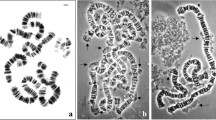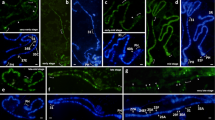Abstract
The presence of heterogeneous RNA of high molecular weight has been demonstrated on the giant chromosomes, in the nuclear sap and in the cytoplasm of the salivary glands in Chironomus tentans. The kinetic properties of this heterogeneous RNA have also been outlined in some detail. — Salivary glands were incubated for different time intervals (20, 45 and 180 min) in haemolymph, supplemented with tritiated cytidine and uridine. The different cellular components were isolated by micromanipulation and RNA extracted with an SDS-pronase solution and analysed with electrophoresis in agarose. — Heterogeneous, high molecular weight RNA with a peak around 35 S was saturated with label on chromosome I, II and III in 45 min, although the synthetic capacity was unchanged during at least 180 min incubation. This indicated a complete turnover of heterogeneous RNA on the chromosomes in less than 45 min. The turnover time in the giant puffs (the so called Balbiani rings) on the fourth chromosome, was even shorter and estimated to less than 30 min. No shift in the electrophoretic pattern of this heterogeneous RNA was found to occur on the chromosomes during long incubation times or during actinomycin D experiments. These labelling characteristics of heterogeneous RNA on the chromosomes indicate that all the different molecules in the heterogeneous RNA have a similar and rapid turnover. A conversion to smaller, stable molecules was excluded. — Heterogeneous RNA of a distribution corresponding to that on the chromosomes was found in the nuclear sap and also in the cytoplasm. The activity in both these cellular compartments increased between 45 and 180 min incubation. The distribution pattern for high molecular weight RNA was in all experiments similar on the chromosomes, in the nuclear sap and in the cytoplasm. It appears that at least a considerable part of the high molecular weight RNA leaves the chromosomes to enter the nuclear sap and lateron to some extent the cytoplasm in this high molecular form. Stable molecules of smaller size (6–15 S) did not appear during 180 min incubation. The data indicate, however, also a substantial breakdown of heterogeneous RNA to acid soluble products during this time.
Similar content being viewed by others
References
Arion, V. J., Georgiev, G. P.: On the functional heterogeneity of chromosomal information. Dokl. Akad. Nauk SSSR 172, 716–719 (1967).
Attardi, G., Parnas, H., Hwang, M.-I. H., Attardi, B.: Giant size rapidly labelled nuclear ribonucleic acid and cytoplasmic messenger ribonucleic acid in immature duck erythrocytes. J. molec. Biol. 20, 145–182 (1966).
Beermann, W.: Kontrollierte RNS-Synthese in Riesenchromosomen. In: Struktur und Funktion des genetischen Materials, S. 211–223. Berlin: Akademie-Verlag 1964.
Brown, D. D., Gurdon, J. B.: Size distribution and stability of DNA-like RNA synthesized during development of anucleolate embryos of Xenopus laevis. J. molec. Biol. 19, 399–422 (1966).
Daneholt, B., Edström, J.-E., Egyházi, E., Lambert, B., Ringborg, U.: Physicochemical properties of chromosomal RNA in Chironomus tentans polytene chromosomes. Chromosoma (Berl.) 28, 379–398 (1969a).
—, RNA synthesis in a Balbiani ring in Chironomus tentans salivary gland cells. Chromosoma (Berl.) 28, 418–429 (1969b).
Darnell, J. E.: Ribonucleic acids from animal cells. Bact. Rev. 32, 262–290 (1968).
Edström, J.-E., Beermann, W.: The base composition of nucleic acids in chromosomes, puffs, nucleoli and cytoplasm of Chironomus salivary gland cells. J. Cell Biol. 14, 371–380 (1962).
—, Daneholt, B.: Sedimentation properties of the newly synthesized RNA from isolated nuclear components of Chironomus tentans salivary gland cells. J. molec. Biol. 28, 331–343 (1967).
Egyházi, E., Daneholt, B., Edström, J.-E., Lambert, B., Ringborg, U.: Low molecular weight RNA in cell components of Chironomus tentans salivary glands. J. molec. Biol. 44, 517–532 (1969).
Georgiev, G. P.: The nature and biosynthesis of nuclear ribonucleic acids. In: Progress in nucleic acid research, vol. VI., p. 259–351 (J. N. Davidson and W. E. Cohn, eds.). New York: Academic Press 1967.
—, Mantieva, V. L.: The isolation of DNA-like and ribosomal RNA from the nucleolo-chromosomal apparatus of mammalian cells. Biochim. biophys. Acta (Amst.) 61, 153–154 (1962).
Greenberg, J. R.: Sedimentation studies on Drosophila virilis salivary gland RNA. J. Cell Biol. 35, 49A-50A (1967).
Harris, H.: Nuclear ribonucleic acid. In: Progress in nucleic acid research, vol. II, p. 20–59 (J. N. Davidson and W. E. Cohn, eds.). New York: Academic Press 1963.
Houssais, J.-F., Attardi, G.: High molecular weight non-ribosomal type nuclear RNA and cytoplasmic RNA in HeLa cells. Proc. nat. Acad. Sci. (Wash.) 56, 616–623 (1966).
Latham, H., Darnell, J.E.: Distribution of m RNA in the cytoplasmic polyribosomes of the HeLa cell. J. molec. Biol. 14, 1–12 (1965).
Pelling, C.: Ribonukleinsäure-Synthese der Riesenchromosomen. Autoradiographische Untersuchungen an Chironomus tentans. Chromosoma (Berl.) 15, 71–122 (1964).
Penman, S., Vesco, C., Penman, M.: Localization and kinetics of formation of nuclear heterodisperse RNA, cytoplasmic heterodisperse RNA and polyribosome associated messenger RNA in HeLa cells. J. molec. Biol. 34, 49–69 (1968).
Perry, R. P.: The cellular sites of synthesis of ribosomal and 4 S RNA. Proc. nat. Acad. Sci. (Wash.) 48, 2179–2186 (1962).
—, Kelley, D. E.: Messenger RNA-protein complexes and newly synthesized ribosomal subunits: analysis of free particles and components of polyribosomes. J. molec. Biol. 35, 37–59 (1968).
Roberts, W. K., Newman, J. F. N.: Use of low concentrations of actinomycin D in the study of RNA synthesis in Ehrlich ascites cells. J. molec. Biol. 20, 63–73 (1966).
Samarina, O. P.: The distribution and properties of cytoplasmic deoxyribonucleic acid-like ribonucleic acid (messenger ribonucleic acid). Biochim. biophys. Acta (Amst.) 91, 688–691 (1964).
Scherrer, K., Latham, H., Darnell, J. E.: Demonstration of an unstable RNA and of a precursor to ribosomal RNA in HeLa cells. Proc. nat. Acad. Sci. (Wash.) 49, 240–248 (1963).
—, Marcaud, L., Zajdela, F., Breckenridge, B., F. Gros: Étude des RNA nucléaires et cytoplasmiques a marquage rapide dans les cellules érythropoiétiques aviaires différenciées. Bull. Soc. Chim. biol. (Paris) 48, 1037–1075 (1966).
—, London, I. M., Gros, F.: Patterns of RNA metabolism in a differentiated cell: a rapidly labelled, unstable 60 S RNA with messenger properties in duck erythroblasts. Proc. nat. Acad. Sci. (Wash.) 56, 1571–1578 (1966).
Schütz, G., Gallwitz D., Sekeris C. E.: Rapidly labelled high molecular RNA from rat liver, Eur. J. Biochem. 4, 149–183 (1968).
Shearer, R. W., McCarthy B. J.: Evidence for ribonucleic acid molecules restricted to the cell nucleus. Biochem 6, 283–289 (1967).
Sibatani, A., Kloet S. R. de, Allfrey V. G., Mirsky A. E.: Isolation of a nuclear fraction resembling DNA in its base composition. Proc. nat. Acad. Sci. (Wash.) 48, 471–477 (1962).
Sirlin, J. L.: Cell sites of RNA and protein synthesis in the salivary gland of Smittia (Chironomidae). Exp. Cell Res. 19, 177–180 (1960).
Soeiro, R., Birnboim H. C., Darnell J. E.: Rapidly labelled HeLa cell nuclear RNA. II. Base composition and cellular localization of a heterogeneous RNA fraction. J. molec. Biol. 19, 362–372 (1966).
—, Vaughan M. H., Warner J. R., Darnell J. E.: The turnover of nuclear DNA-like RNA in HeLa cells. J. Cell. Biol. 39, 112–119 (1968).
Warner, J. R., Soeiro R., Birnboim H. C., Girard M., Darnell J. E.: Rapidly labelled HeLa cell nuclear RNA. I. Identification by zone sedimentation of a heterogeneous fraction separate from ribosomal precursor RNA. J. molec. Biol. 19, 349–361 (1966).
Author information
Authors and Affiliations
Rights and permissions
About this article
Cite this article
Daneholt, B., Edström, J.E., Egyházi, E. et al. Chromosomal RNA synthesis in polytene chromosomes of Chironomus tentans . Chromosoma 28, 399–417 (1969). https://doi.org/10.1007/BF00284257
Received:
Accepted:
Issue Date:
DOI: https://doi.org/10.1007/BF00284257




